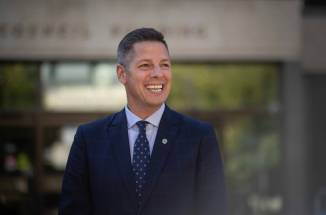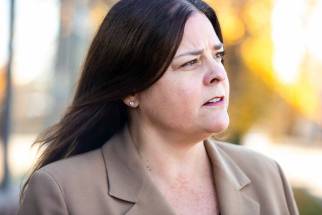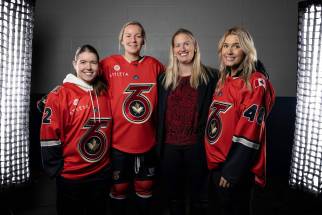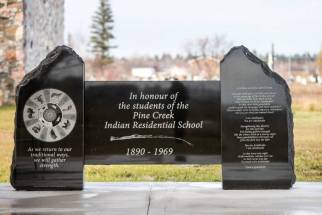Stepping beyond sound Local program designed to make dance classes more accessible to deaf students
Read this article for free:
or
Already have an account? Log in here »
To continue reading, please subscribe:
Monthly Digital Subscription
$0 for the first 4 weeks*
- Enjoy unlimited reading on winnipegfreepress.com
- Read the E-Edition, our digital replica newspaper
- Access News Break, our award-winning app
- Play interactive puzzles
*No charge for 4 weeks then price increases to the regular rate of $19.00 plus GST every four weeks. Offer available to new and qualified returning subscribers only. Cancel any time.
Monthly Digital Subscription
$4.75/week*
- Enjoy unlimited reading on winnipegfreepress.com
- Read the E-Edition, our digital replica newspaper
- Access News Break, our award-winning app
- Play interactive puzzles
*Billed as $19 plus GST every four weeks. Cancel any time.
To continue reading, please subscribe:
Add Free Press access to your Brandon Sun subscription for only an additional
$1 for the first 4 weeks*
*Your next subscription payment will increase by $1.00 and you will be charged $16.99 plus GST for four weeks. After four weeks, your payment will increase to $23.99 plus GST every four weeks.
Read unlimited articles for free today:
or
Already have an account? Log in here »
Hey there, time traveller!
This article was published 19/10/2022 (1144 days ago), so information in it may no longer be current.
Nicole Kepp has been teaching dance for more than 20 years. She has plenty of methods for correcting missteps and perfecting form and, as principal of the Royal Winnipeg Ballet School’s recreational division, she’s coached students of all ages and skill levels.
Recently, however, Kepp realized she still has some learning to do.
“It makes sure that I open up my eyes to everybody in the room,” she says of A New Rhythm: Teaching Beyond Sound, a local teacher-training program designed to make dance classes more accessible for deaf and hard-of-hearing students. “It’s about ensuring that you’re providing communication so that everyone can understand.”
New Rhythm is a first-of-its-kind project from the Manitoba Cultural Society for the Deaf, also known as Deaf Arts Manitoba or DAM. The organization’s mission is to promote inclusion and create opportunities for the deaf community to be involved in all facets of arts and culture activities in Manitoba.
So far, dance remains an underrepresented artform among members — although not for lack of interest.
MIKAELA MACKENZIE / WINNIPEG FREE PRESS Nicole Kepp of the Royal Winnipeg Ballet recreational division principal (left) and Alice Crawford, project director for Deaf Arts Manitoba.
“There are people who would like to take dance lessons,” says Alice Crawford, DAM’s project director and lead on the New Rhythm project. “If they have teachers who know what they need, they can fully participate. But if they don’t, it can be a really hard experience.”
Crawford recalls one member who loved dance as a child, but ended up dropping out of a dance program because it wasn’t accommodating.
Communication is one of the main barriers facing deaf and hard-of-hearing dance hopefuls. New Rhythm aims to address this, and other gaps, through a series of instructional videos and a cultural workshop.
Upon completion, dance teachers will receive a certificate and their studios will be listed on DAM’s website. The goal is to create a directory for parents and adults seeking informed and inclusive teachers.
The project is funded through grants from the Canada Council for the Arts and the Manitoba Arts Council and promoted in collaboration with Dance Manitoba.
Kepp became aware of the program when the RWB was brought on to help produce the training videos. Filming, which took place in the school’s studios, was an illuminating experience.
“I was teaching a step and you rely, as a teacher, a lot on using the mirror,” Kepp says. “When you turned your back on the (class), I realized nobody could hear me.”
“There are people who would like to take dance lessons… If they have teachers who know what they need, they can fully participate. But if they don’t, it can be a really hard experience.”–Alice Crawford
She had to find different ways to demonstrate movements and make sure the dancers on set could see her instructions at all times. Learning basic American Sign Language for common dance terminology, such as numbers for counting out steps and the sign for water, also enabled her to communicate more effectively.
Kepp has since shared the New Rhythm videos with her students in the RWB School’s teacher-training program.
“They were like, ‘Oh, I had never thought about it that way,” she says. “It built upon the things we (as hearing dance teachers) take for granted or things that we just wouldn’t have been aware of.”
The videos and accompanying teaching manuals include strategies for working with ASL interpreters, tactics for getting the attention of the class and tips for sharing instructions non-verbally.
MIKAELA MACKENZIE / WINNIPEG FREE PRESS Royal Winnipeg Ballet instructor Nicole Kepp, left, is learning how to teach deaf students with the help of A New Rhythm: Teaching Beyond Sound, a unique project spearhearded by Alice Crawford, right, of Deaf Arts Manitoba.
Music — a major component of dance — can be made more accessible by giving students songs ahead of time, placing speakers on the floor so dancers can feel the beat and tempo, and turning up the volume. These strategies can be applied to any form of dance and the New Rhythm videos feature contemporary, hip-hop and jazz styles.
The videos, as well as a panel discussion with deaf and hard-of-hearing dancers, are available free on DAM’s website (mcsd-dam.com). Instructors seeking a certificate are also required to take a two-day paid workshop, called Breaking the Sound Barrier, facilitated by local actors Shannon Guile and Joanna Hawkins.
“They talk about deaf culture and they talk about the myths that are out there about deaf people,” Crawford says. “And they’ll have some practice sessions where hearing dance instructors will interact with deaf people.”
“They talk about deaf culture and they talk about the myths that are out there about deaf people… And they’ll have some practice sessions where hearing dance instructors will interact with deaf people.”–Alice Crawford
The next workshop is scheduled to take place in February; interested teachers can reach out to Crawford at projects@mcsd-dam.com for more information.
New Rhythm is still very much in its infancy, but Crawford hopes the program will create inroads for the deaf community to participate in dance recreationally and professionally. “Hopefully, eventually, we can have a dance troupe,” she says. “This is just baby steps.”
Kepp sees it as a chance to get more people involved in an artform she loves.
“It provides an opportunity for teachers to ensure their class is accessible to everybody,” she says. “I think that’s really great.”
eva.wasney@winnipegfreepress.com
Twitter: @evawasney

Our newsroom depends on a growing audience of readers to power our journalism. If you are not a paid reader, please consider becoming a subscriber.
Our newsroom depends on its audience of readers to power our journalism. Thank you for your support.







